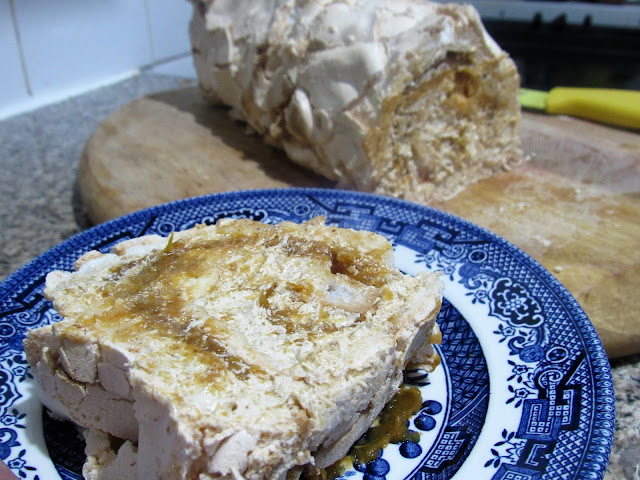This week on GBBO was dessert-themed, with meringue roulades being the signature challenge. Now, I'm not too good with meringue, I have a bit of a love-hate relationship when making it. However, following my success following bits of Dan's recipes before, I decided to give his meringue base a crack, and wow, it worked really well!!
However, I went very off-piste with the filling. I can't eat double cream without having a bad stomach, so I avoid it wherever possible. 99% of the roulade recipes I found used a whipped cream, which made me pretty sad. So, whilst walking today, I thought of this concoction - french buttercream is lovely and silky and holds it's shape well when spread. I've flavoured it with coffee before, and whilst thinking of this, I remembered my adoration of the pumpkin spiced latte.
So, this roulade is filling with a coffee creme aux beurre (French buttercream) and a lightly sweetened (but heavily cinnamon-ed) pumpkin (but I used butternut squash, which works just as well) puree.
This is brilliant for a relaxed after dinner dessert, not too sweet because of the coffee, but just enough so you know you're having a treat.
Enjoy!!!
Makes one roulade (serves 8-10)
Ingredients:
For the roulade:
- 4 egg whites
- 250g (1 & 1/4 cups) caster sugar
- 1 tsp white wine vinegar
- 1 tsp vanilla extract
- 1 tsp cornflour
For the French coffee buttercream:
- 4 egg yolks
- 125g (5/8 cup) caster sugar
- 2 tbsp water
- 125g (1/2 cup) butter/baking margarine, at room temperature
- 2 tsp ground coffee dissolved in 1 tbsp boiling water
For the sweetened pumpkin puree:
- 500g (3 & 1/3 cups) frozen pumpkin/butternut squash
- 60g (1/3 cup) light soft brown sugar
- 1 tbsp ground cinnamon
- 1 tsp ground ginger
- 1/2 tsp ground nutmeg
- 1/4 tsp salt
- Zest of one orange
Method:
1. Preheat your oven to 180c (160c fan)/355f/gas mark 4. Grease and line the base of a 20 x 30cm swiss roll tray.
2. In a spotlessly clean bowl (I used the bowl in a stand mixer), pour the egg whites and whisk on a medium speed until they have at least tripled in volume and turned white.
3. One tablespoon at a time, add the caster sugar and continue whisking for 5-7 minutes until stiff peaks form when the whisk is lifted from the bowl, and the meringue is white and glossy.
4. Add the vinegar, vanilla and cornflour and gently fold in with a spatula. Pour onto the prepared baking tray and smooth out as evenly as you can.
5. Bake for around 20 minutes, or until the top has browned slightly and is crisp.
6. Make the pumpkin puree by placing the pumpkin/butternut squash in a microwave safe bowl. Add a splash of water then put in a microwave on high power for 5 minutes. Stir and repeat, until the squash/pumpkin is cooked through (soft all the way through). Leave to cool for 5 minutes.
7. Blitz the pumpkin/squash in a blender/food processor until smooth. Pour into a mixing bowl, and then add the remaining pumpkin puree ingredients. Stir to combine, then set aside to cool to room temperature.
8. Make the coffee buttercream. Place the caster sugar and water in a saucepan on a medium heat. Heat until a sugar thermometer dipped into the mixture reads 121c/249f. Meanwhile, pour the egg yolks into the bowl of a stand mixer (with the whisk attached). Start whisking on a low speed.
9. Once the sugar is up to temperature, carefully and slowly, pour the hot sugar over the egg yolks, keeping the speed of the mixer low. Once all of the syrup has been added, turn the speed of the mixer up (to about medium), and leave to whisk for around 10 minutes, until the mixture is at room temperature.
10. Whilst whisking, add the butter in small pieces gradually and then leave to whisk for another few minutes. Add the coffee, then whisk for 3-4 minutes until you have a silky, spreadable buttercream. Place in the fridge until you're ready to assemble.
11. To finish the roulade, flip the meringue out onto a work surface. Carefully peel off the baking parchment. Spread over the coffee buttercream, followed by the pumpkin puree.
12. Roll the roulade up along one of the short sides. Cracks will happen, but that's okay (it adds to the charm I think!).
13. Enjoy!








